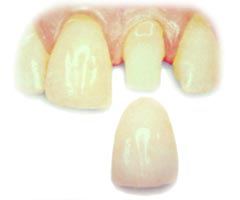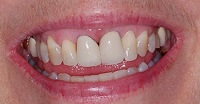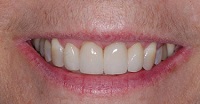Arnold, MD Porcelain Crowns
 If you have a damaged tooth that needs restoration, a crown may be best. While we can restore a small cavity with a composite filling, more extensive damage may necessitate a crown. A crown, sometimes called a cap, protects the remaining tooth from further damage and restores it to a whole and healthy state. When a crown made by an artistically inclined dentist like Dr. Esposito, no one will be able to tell it’s not real. Furthermore, a well-made crown will be completely comfortable.
If you have a damaged tooth that needs restoration, a crown may be best. While we can restore a small cavity with a composite filling, more extensive damage may necessitate a crown. A crown, sometimes called a cap, protects the remaining tooth from further damage and restores it to a whole and healthy state. When a crown made by an artistically inclined dentist like Dr. Esposito, no one will be able to tell it’s not real. Furthermore, a well-made crown will be completely comfortable.
Porcelain-Fused-to-Metal Crowns
Porcelain-fused-to-metal crowns consist of a metal interior that gives the crown its structure and an external layer of porcelain that mimics a real tooth’s appearance. One advantage of PFM crowns is their strength. An all-porcelain crown can break under heavy chewing pressure. But newer dental ceramics are strong enough to serve even on back teeth.
Here are some of the disadvantages of PFM crowns:
- They have a flat appearance, with none of the natural sparkle of real teeth.
- Over time, a dark line will develop where the PFM crown meets the gum line.
- Since metal is conductive, new PFM crowns in some cases can cause sensitivity to heat and cold for a few weeks.
- Some people have allergies or sensitivities to some metals that are present in crowns.
At Chesapeake Dental Arts, we prefer all-ceramic metal-free crowns. They offer the most natural appearance, plus they have excellent strength and durability.


Placing Porcelain Crowns
Before Dr. Esposito can place a crown, the tooth will have to be shaped to hold it securely. New technology enables us to avoid the messy impression materials that traditionally had to be used. Instead we take detailed optical scans of the preparation and the surrounding teeth. The laboratory will use these scans to create a crown that is perfectly shaped for your mouth. It’s important that this new tooth not disrupt your natural bite. Then we will place a temporary crown over the prepared tooth while we wait for your new crown to come back from the lab.
We work closely with Bay View Dental Laboratory, which is a member of the Dawson Academy Laboratory Association and accredited by the American Academy of Cosmetic Dentistry. Besides giving us crowns that perfectly fit your mouth and bite comfortably, the crowns are beautiful and perfectly natural. Before Dr. Esposito cements your new crown into place, you’ll be able to try it in. If it doesn’t look exactly the way you want, we will send it back to the lab for adjustments. Primarily, we use two types of porcelain crowns:
e.max crowns
e.max crowns are made of lithium disilicate, a very strong ceramic. Lab technicians will use a single block of this material to create your crown. The milled block of lithium disilicate will then be layered with nuanced porcelain to perfectly match the coloration of your natural teeth. They are excellent for front teeth.
Zirconia crowns
Zirconia crowns are the strongest of the ceramic crowns. They are again milled out of a block of material, so they will be a single color, which will look fine for a back tooth but may not look completely natural on a front tooth. Their superior strength makes them a good choice for back teeth and patients with bruxism. Like e.max crowns, zirconia crowns can be layered with porcelain at the lab for beautiful color gradations that make them look perfectly natural.
To maximize the life of your porcelain crowns, practice good dental hygiene and avoid activities that could damage them. For example, don’t tear packaging open with your teeth or chew on ice.
If you would like to make an appointment at Chesapeake Dental Arts, please call us at 410-757-6200. You can also fill out this form, and we will call you.






